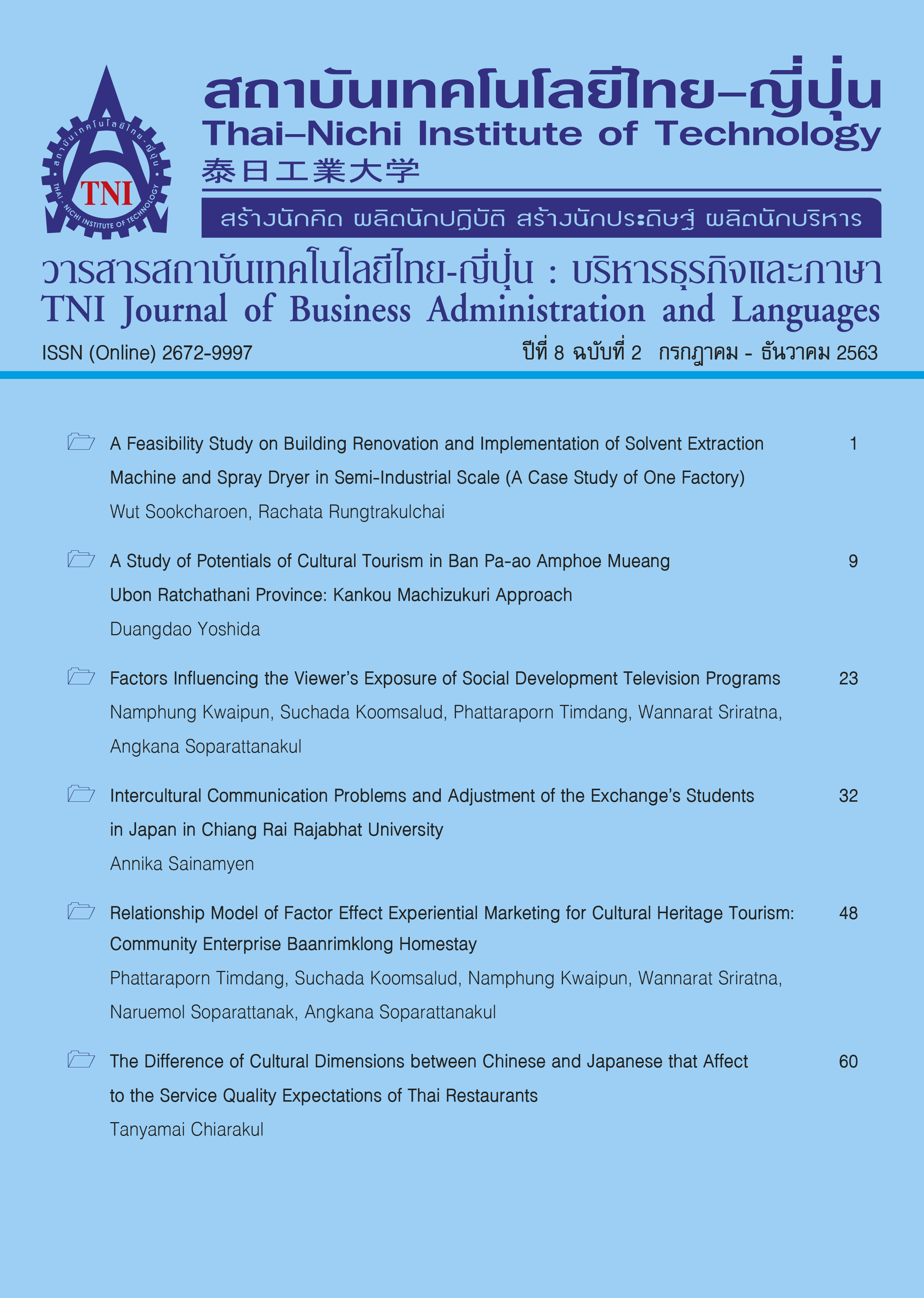ปัจจัยที่มีอิทธิพลต่อการเลือกรับชมรายการโทรทัศน์ เพื่อสร้างแรงบันดาลใจ สร้างสรรค์สังคม
Main Article Content
บทคัดย่อ
งานวิจัยนี้ มีวัตถุประสงค์เพื่อศึกษาปัจจัยที่มีอิทธิพลต่อการเลือกรับชมรายการโทรทัศน์เพื่อสร้างแรงบันดาลใจ สร้างสรรค์สังคม เครื่องมือที่ใช้ในการวิจัยได้แก่ แบบสอบถาม ใช้วิธีการสุ่มตัวอย่างแบบเจาะจง (Purposive Sampling) เก็บรวบรวมข้อมูลจากผู้ที่เคยชมรายการโทรทัศน์เพื่อสร้างแรงบันดาลใจ สร้างสรรค์สังคม ได้จำนวนตัวอย่างทั้งสิ้น 400 คน วิเคราะห์ข้อมูลโดยใช้โปรแกรมสำเร็จรูปทางสถิติ ใช้สถิติเชิงพรรณาและสถิติวิเคราะห์ความถดถอยเชิงพหุ ผลการศึกษาพบว่า ปัจจัยส่วนใหญ่มีอิทธิพลต่อการเลือกรับชมรายการโทรทัศน์เพื่อสร้างแรงบันดาลใจ สร้างสรรค์สังคม มีค่าเฉลี่ยในระดับมาก โดยปัจจัยด้านผู้ร่วมรายการมีอิทธิพลในระดับมากที่สุด รองลงมาได้แก่ ด้านเนื้อหารายการ ด้านบรรยากาศของรายการ ด้านรูปแบบการนำเสนอรายการ ด้านผู้ดำเนินรายการ และด้านวัตถุประสงค์ของรายการ เมื่อทำการวิเคราะห์ความถดถอยเชิงพหุพบว่า ปัจจัยที่มีอิทธิพลต่อการเลือกรับชมรายการโทรทัศน์เพื่อสร้างแรงบันดาลใจ สร้างสรรค์สังคม มีอิทธิพลมาจากปัจจัยด้านเนื้อหารายการมากที่สุด รองลงมาคือ ด้านรูปแบบการนำเสนอรายการ ด้านวัตถุประสงค์ของรายการ ด้านผู้ดำเนินรายการ ด้านผู้ร่วมรายการ และด้านบรรยากาศของรายการ ตามลำดับ โดยมีอิทธิพลถึง ร้อยละ 78.01 ณ ระดับนัยสำคัญ 0.05
Article Details
นโยบายการรับบทความ
กองบรรณาธิการวารสารสถาบันเทคโนโลยีไทย-ญี่ปุ่น มีความยินดีรับบทความจากอาจารย์ นักศึกษา และผู้ทรงคุณวุฒิในสาขาบริหารธุรกิจและภาษา ที่เขียนเป็นภาษาไทยหรือภาษาอังกฤษ ซึ่งผลงานวิชาการที่ส่งมาขอตีพิมพ์ต้องไม่เคยเผยแพร่ในสิ่งพิมพ์อื่นใดมาก่อน และต้องไม่อยู่ในระหว่างการพิจารณาของวารสารอื่นที่นำส่ง ดังนั้นผู้สนใจที่จะร่วมเผยแพร่ผลงานและความรู้ที่ศึกษามาสามารถนำส่งบทความได้ที่กองบรรณาธิการเพื่อเสนอต่อคณะกรรมการกลั่นกรองบทความพิจารณาจัดพิมพ์ในวารสารต่อไป ทั้งนี้บทความที่สามารถเผยแพร่ได้ประกอบด้วยบทความวิจัย ผู้สนใจสามารถศึกษาและจัดเตรียมบทความจากคำแนะนำสำหรับผู้เขียนบทความ
การละเมิดลิขสิทธิ์ถือเป็นความรับผิดชอบของผู้ส่งบทความโดยตรง บทความที่ได้รับการตีพิมพ์ต้องผ่านการพิจารณากลั่นกรองคุณภาพจากผู้ทรงคุณวุฒิและได้รับความเห็นชอบจาก กองบรรณาธิการ
ข้อความที่ปรากฏภายในบทความของแต่ละบทความที่ตีพิมพ์ในวารสารวิชาการเล่มนี้ เป็น ความคิดเห็นส่วนตัวของผู้เขียนแต่ละท่าน ไม่เกี่ยวข้องกับสถาบันเทคโนโลยีไทย-ญี่ปุ่น และคณาจารย์ท่านอื่น ๆ ในสถาบัน แต่อย่างใด ความรับผิดชอบด้านเนื้อหาและการตรวจร่างบทความแต่ละบทความเป็นของผู้เขียนแต่ละท่าน หากมีความผิดพลาดใด ๆ ผู้เขียนแต่ละท่านจะต้องรับผิดชอบบทความของตนเองแต่ผู้เดียว
กองบรรณาธิการขอสงวนสิทธิ์มิให้นำเนื้อหา ทัศนะ หรือข้อคิดเห็นใด ๆ ของบทความในวารสารวิชาการ สถาบันเทคโนโลยีไทย-ญี่ปุ่น ไปเผยแพร่ก่อนได้รับอนุญาตจากผู้นิพนธ์อย่างเป็นลายลักษณ์อักษร ผลงานที่ได้รับการตีพิมพ์ถือเป็นลิขสิทธิ์ของวารสารสถาบันเทคโนโลยีไทย-ญี่ปุ่น
หากต้องการสอบถามข้อมูลเพิ่มเติมที่
- กองบรรณาธิการ วารสารสถาบันเทคโนโลยีไทย-ญี่ปุ่น
- ฝ่ายวิจัยและนวัตกรรม สถาบันเทคโนโลยีไทย-ญี่ปุ่น
เลขที่ 1771/1 สถาบันเทคโนโลยีไทย-ญี่ปุ่น ซอยพัฒนาการ 37-39 ถนนพัฒนาการ แขวงสวนหลวง เขตสวนหลวง กรุงเทพมหานคร 10250 ติดต่อกับคุณพิมพ์รต พิพัฒนกุล (02) 763-2752 , คุณอาริสา จิระเวชถาวร (02) 763-2600 Ext. 2704 Fax. (02) 763-2754 หรือ E-mail: JBAL@tni.ac.th
เอกสารอ้างอิง
Chompunuch Naksukpan. (2014). Exposure, perception, user and gratification towards “Women and Women” TV program of the audience in Bangkok. (in Thai). (Master’s thesis, Dhurakij Pundit University). Retrieved from http://libdoc.dpu.ac.th/thesis/156174.pdf
Cronbach, L. J. (1990). How to judge tests: Reliability and other qualities. Essentials of psychological testing. New York: Collins.
Duangruethai Nilphet. (2013). The study of presentation of television economic news program broadcast by money channel A television station for business and investment. Veridian E-Journal Silpakorn University, 6(1), 526-535.
Dusadee Yoelao, Wilailuck Langka, Saran Pimthong & Narisara Peungposop. (2013). The evaluation of watching movies for enhancing inspiration of undergraduate students at Srinakharinwirot University. (in Thai). Retrieved from http://bsris.swu.ac.th/upload/153.pdf
Hair, J. A.,Tatham, T. R., & Black, W. (1998). Multivariate data analysis. New York: Prentice Hall.
Hair, O.F., A. Money, P. Samuel & M. Page. (2007). Research methods for business. Chichester: John Wiley & Sons.
Hunt, T., & Ruben, B. D. (1993). Mass communication: Producer and consumers. New York: HarperCollins.
Jaruwan Nitipaiboon, Santat Thongrin & Wittayatorn Torkaew. (2016). Television programs development for elderly. (in Thai). Journal of Graduate Studies Valaya Alongkorn Rajabhat University, 10(2), 21-39.
McCombs, M. E. & Becker, L. B. (1979). Using mass communication theory. New York: Prentice-Hall.
Pimkhae Sricharoen. (2016). Audience’s viewing behavior and satisfaction of at ten day television program on channel 3. (in Thai). (Master’s thesis, Thammasat University). Retrieved from http://ethesisarchive.library.tu.ac.th/thesis/2016/TU_2016_5707010145_5053_3850.pdf
Pornchai Phanchaiphom. (2015). Behavior and satisfaction on the viewing “Kubkaokoppladen” of modern nine TV of the audience in Bangkok. (in Thai). Journal of Graduate School Dhurakij Pundit University, 5(1), 825-832.
Prapuetchob, T. (2017). How to captivate and engage audiences with cartoon. (in Thai). Journal of Communication and Management NIDA, 1(1), 1-13.
Santat Thongrin. (2015). Television production management. In Teaching documents, academic series production introductory television programs units 2, (4th ed.). (pp.9-11.). Nonthaburi: Sukhothai Thammathirat University.
S.S Anacamee. (2009). Creative power of the inspiration. Bangkok: Siam Miss Publishing House.
TheMATTER. (2018). “Passion” How important is it if I don't have life to go on?. (in Thai). Retrieved from https://thematter.co/sponsor/follow-your-passion/4627.
The National Broadcasting and Telecommunications Commission. (2019). Survey behavior and trends to watch animation of Thailand in 2562. (in Thai). Retrieved from http://broadcast.nbtc.go.th/data/academic/file/630300000001.pdf.
Wipornrat Yaowalaong. (2015). Exposure behaviors and gratification of audience in Bangkok metropolis toward Yoktupkhaochao Program on PPTV Channel. (in Thai). (Master’s thesis, Thammasat University). Retrieved from http://ethesisarchive.library.tu.ac.th/thesis/2015/TU_2015_5707010277_4331_3332.pdf


